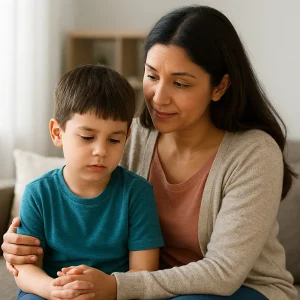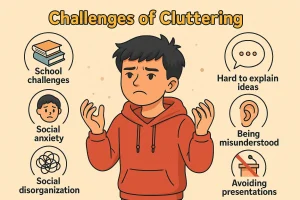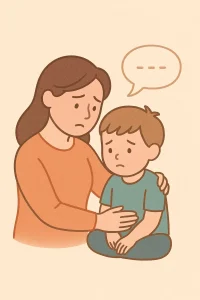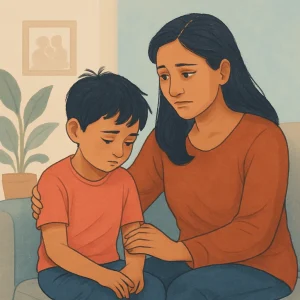How to Communicate Effectively in a Multi-Generational Household
By Prapoorna M
Last Updated: February 29, 2024
In today’s world, where families are becoming more diverse and dynamic, multigenerational living has become increasingly common. It’s not unusual to find grandparents, parents, and children under one roof, navigating daily life together. This living arrangement, while enriching, brings its own set of communication challenges. Imagine a scenario where a teenager’s love for instant messaging meets the more traditional communication style of their grandparents. The gap in preferences and understanding can lead to misunderstandings and frustrations.
Effective communication across these generational divides is not just beneficial but essential. It ensures that every family member feels heard, respected, and valued, regardless of their age. A harmonious household is one where communication flows smoothly, bridging the gaps between different ages and experiences.
Remember, communication is the heart of family life. Let’s learn how to keep it healthy and strong in a multigenerational household.
Book Relationship Counselling now.
Understanding Different Generational Communication Styles
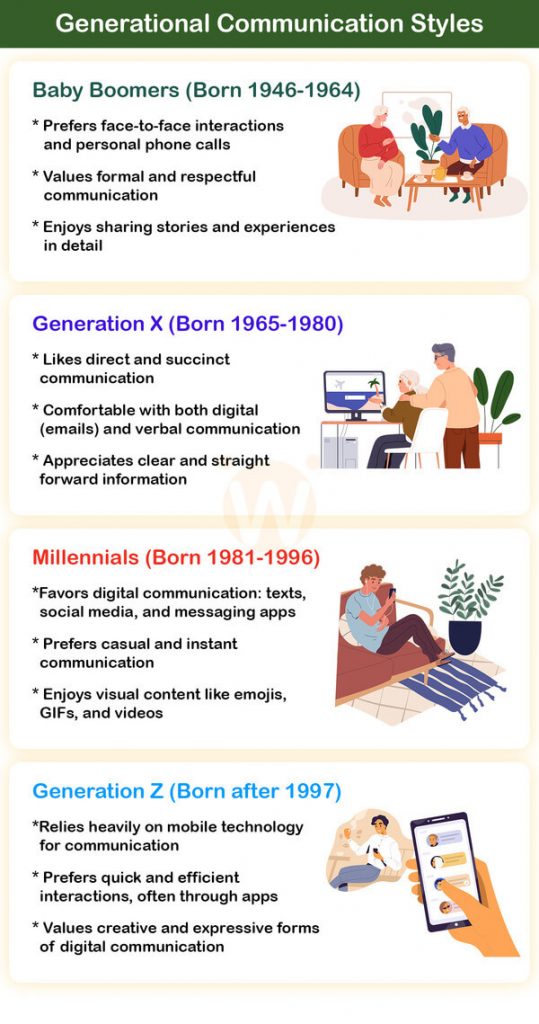
In a household where multiple generations coexist, understanding the distinct communication styles of each generation is crucial. Let’s start by looking at some typical characteristics:
- Baby Boomers (Born 1946-1964): Often preferring direct, face-to-face interactions, Baby Boomers value more personal forms of communication. They might find deep satisfaction in lengthy conversations and often view them as a sign of respect and genuine interest.
- Generation X (Born 1965-1980): This generation is known for its blend of traditional and digital communication preferences. Gen Xers are comfortable with emails and phone calls but don’t shy away from newer technologies. They value clear, concise, and practical communication.
- Millennials (Born 1981-1996): Growing up during the digital revolution, Millennials are adept at communicating via text and social media platforms. They value quick and efficient communication but also appreciate the personal touch of face-to-face interactions, especially in meaningful conversations.
- Generation Z (Born after 1997): The true digital natives, Gen Z members are most comfortable with instant messaging, social media, and other online platforms. They value speed and convenience but are also drawn to visual and creative forms of communication like emojis, GIFs, and videos.
Discover more about the impact of generational differences in our article on inter-caste interracial marriage, highlighting the importance of understanding and embracing diversity within families.
Embracing Technology for Better Connectivity
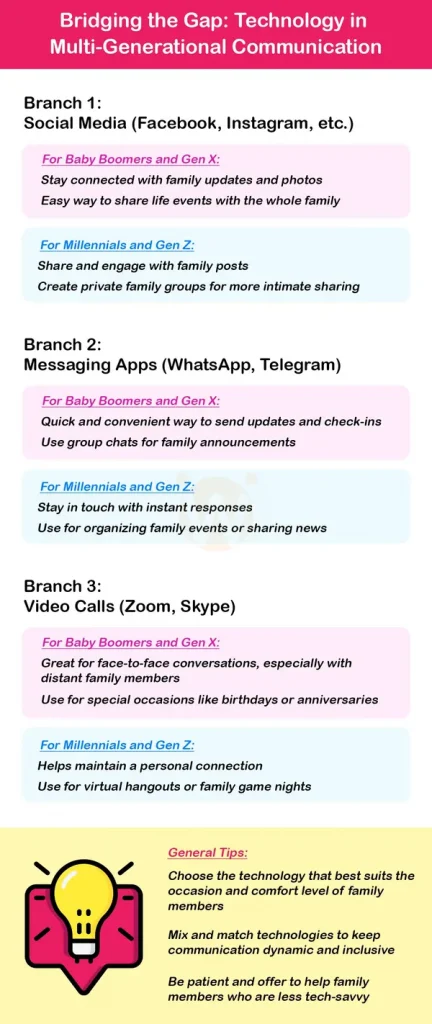
In today’s world, technology plays a pivotal role in bridging the communication gap between generations. Smartphones, social media, and various messaging apps offer incredible opportunities to stay connected, share experiences, and understand each other better.
Also read: Social Media’s Impact on Relationships Explained
Here are some tips for making the most of these technologies:
- For Seniors: Embracing smartphones and social media can be a game-changer. Start with the basics like sending texts or setting up a social media account to stay updated with family activities. Don’t hesitate to ask younger family members for a quick tutorial—they usually love to share their knowledge!
- For Younger Generations: Show patience and empathy when introducing new technologies to older family members. Remember, it’s not just about teaching them how to use a device, but also about understanding why it’s meaningful to them.
- Family Tech-Time: Schedule regular video calls or create a family group on a messaging app. This keeps everyone in the loop, regardless of where they are.
Wellness Hub understands the importance of staying connected in a multigenerational household. We offer resources and guidance for families looking to improve their digital communication skills, ensuring that everyone, regardless of age, feels included and valued. Check out our family wellness resources for more tips on effective communication within your family.
The Power of Active Listening and Empathy
Active listening is more than just hearing the words being said; it’s about fully engaging with the speaker. In a multi-generational household, where perspectives and experiences vary widely, active listening becomes a cornerstone for mutual understanding. Here’s how to practice it:
- Give Full Attention: Put away distractions. Focus entirely on the person speaking. This shows that you value their words and are genuinely interested in what they have to say.
- Reflect and Clarify: Repeat what you’ve heard in your own words. This not only ensures you’ve understood correctly but also makes the speaker feel heard and validated.
- Ask Open-Ended Questions: Encourage elaboration and deeper insight into their thoughts and feelings. It’s a great way to show that you are interested and engaged.
- Avoid Immediate Judgment: Reserve your opinions or advice until the person has fully expressed themselves. This creates a safe space for open and honest communication.
Empathy, on the other hand, involves stepping into the shoes of others and understanding their feelings and perspectives. In a household with diverse age groups, empathy helps bridge the emotional and experiential gaps. When you empathize, you acknowledge the validity of others’ feelings, which is crucial for building trust and strong familial bonds.
Enhance your understanding of empathy in family relationships by reading our article on the importance of empathy in life.
Active Listening Techniques for Better Family Communication
| Technique | Description | Example |
|---|---|---|
| Paraphrasing | Restating what was said in your own words to show understanding and ensure clarity. | Family member: “I’m stressed about school.” You: “It sounds like you’re feeling really overwhelmed with your classes.” |
| Open-Ended Questions | Asking questions that require more than a yes/no answer to encourage deeper conversation. | “What was the most interesting part of your day today?” |
| Non-Verbal Cues | Using body language and facial expressions to show you are engaged and empathetic. | Nodding, maintaining eye contact, leaning in slightly. |
| Reflecting Feelings | Acknowledging and naming the emotions that the speaker might be expressing. | “It seems like you’re feeling frustrated about that situation.” |
| Summarizing | Briefly restating the main points of what the speaker has said to demonstrate understanding. | “So, what you’re saying is that you need more support with your project, is that right?” |
| Validating | Showing acceptance and understanding of the speaker’s perspective, even if you don’t agree. | “I can see why you would feel that way given the circumstances.” |
| Asking for Clarification | Requesting more information or elaboration to fully understand the speaker’s point. | “Can you tell me more about what happened?” |
Balancing Personal Space with Family Engagement
While close family ties are invaluable, respecting personal space is equally important.
Here’s how to strike a balance:
- Respect Privacy: Recognize and honor each family member’s need for privacy and alone time. This respect fosters a healthy environment where everyone feels comfortable.
- Set Clear Boundaries: Discuss and mutually agree on boundaries regarding personal spaces, shared areas, and communication times. Clear boundaries help avoid conflicts and misunderstandings.
- Engage in Shared Interests: Find common hobbies or activities that you can enjoy together. It could be a weekly movie night, a gardening project, or cooking a family meal together. This not only strengthens relationships but also creates a platform for casual and comfortable communication.
- Encourage Individuality: Celebrate each family member’s unique interests and passions. Showing interest in their activities demonstrates your care and helps build deeper connections.
Know more about Online Family counselling
Group Activities and Shared Experiences
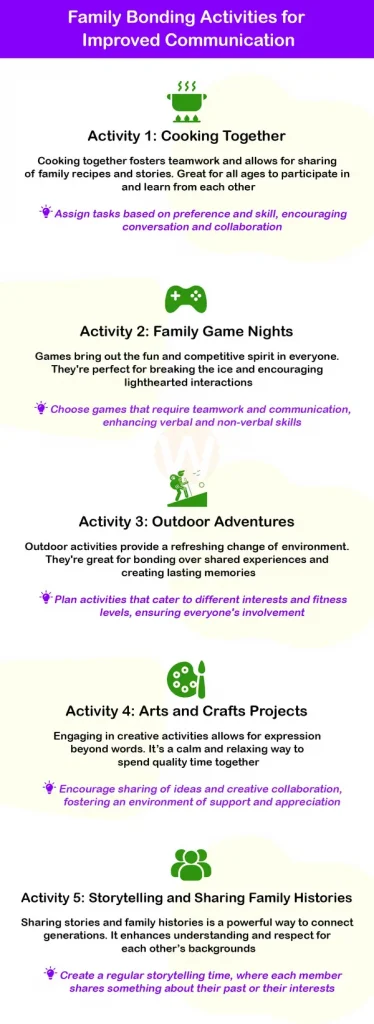
One of the joys of a multi-generational household is the wealth of experiences and interests each member brings. Engaging in group activities is a fantastic way to improve communication and strengthen familial bonds. Here are some ideas to get everyone involved:
- Family Game Nights: Whether it’s board games, card games, or interactive video games, game nights are a fun way to engage all family members. They encourage teamwork, laughter, and healthy competition.
- Cooking Together: Preparing a meal together is not just about the food; it’s a chance to share recipes, stories, and skills. From grandparents passing down traditional dishes to youngsters experimenting with new cuisines, the kitchen can be a lively hub of family bonding.
- Outdoor Activities: Activities like hiking, picnics, or gardening can be therapeutic and refreshing. They offer a change of scenery and a break from digital screens, allowing family members to connect with nature and each other.
- Arts and Crafts: This can be especially enjoyable and relaxing. Engaging in creative projects like painting, crafting, or DIY home projects can cater to various interests and age groups.
Shared experiences like these not only help improve communication but also create lasting memories and strengthen the familial fabric. It’s about finding joy in each other’s company and learning from one another.
Read more about Marital Bliss: How to Make Your Marital Life Blissful?
Resolving Conflicts and Setting Boundaries
Conflict is natural in any family, more so in a multi-generational one. The key is to handle conflicts constructively and set effective boundaries. Here’s how:
- Open and Honest Communication: Encourage family members to express their feelings and concerns openly but respectfully. This transparency can prevent misunderstandings and resentments from building up.
- Mediation and Compromise: When conflicts arise, try to mediate and find a middle ground. Compromises show that everyone’s opinion is valued and that you are working together as a team.
- Respect Boundaries: Understand and respect the personal boundaries of each family member. This could be about space, privacy, or even certain topics that are off-limits for discussion.
- Seek External Support if Needed: Sometimes, it helps to get an outside perspective. Family counseling or guidance from platforms like Wellness Hub can offer valuable tools and strategies for conflict resolution and boundary setting.
Remember, the goal is not to eliminate conflict entirely but to manage it in a way that strengthens family relationships rather than weakening them.
For more insights on managing disagreements and maintaining harmony, read our article on better ways to communicate in relationships.
Conflict Resolution Strategies in Multi-Generational Households
| Strategy | Description | When to Use |
|---|---|---|
| Open Communication | Encourage honest and respectful dialogue to express feelings and viewpoints. | Use when there’s a misunderstanding or when someone feels unheard. |
| Compromise | Finding a middle ground where each party gives up something to reach a solution. | Best for situations where both parties have valid but conflicting needs or desires. |
| Time-Outs | Taking a break from the discussion to cool down and collect thoughts. | When emotions run high and a calm, constructive conversation isn’t possible. |
| Active Listening | Listening attentively to understand the other person’s perspective without interruption. | In all types of conflicts, to ensure all parties feel heard and understood. |
| Setting Boundaries | Clearly defining what is acceptable behavior and communication. | To prevent conflicts from escalating and to establish mutual respect. |
| Seeking Mediation | Involving a neutral third party to facilitate the resolution process. | For more complex conflicts where an unbiased perspective can help find a solution. |
| Expressing Empathy | Showing understanding and compassion for the other person’s feelings. | To build trust and understanding, especially when resolving personal conflicts. |
Celebrating Diversity and Building Family Traditions
In a multi-generational household, each member brings a unique slice of history and culture. Celebrating this diversity can turn everyday life into a rich tapestry of experiences and stories. Here’s how you can honor this diversity:
- Share Family Histories: Encourage family members of different generations to share stories and experiences from their past. This could be through photo albums, old letters, or simply reminiscing over a cup of tea. These stories help younger generations understand their heritage and develop a deeper sense of belonging.
- Establish New Traditions: While respecting existing family traditions, don’t shy away from creating new ones that encompass the interests and values of all generations. This could be a special family ritual, a yearly celebration, or even a regular family activity that everyone looks forward to.
- Learn from Each Other: Take the opportunity to learn about the different cultural and historical backgrounds within your family. This could be through cooking traditional meals together, celebrating diverse festivals, or even learning a family language.
Explore more How Should the Relationship between Mother-In-Law and Daughter-In-Law be?
By valuing the diversity within your family, you create an environment of mutual respect and understanding. This not only strengthens familial bonds but also enriches the family’s collective experience.
Understand the dynamics of different family relationships, such as the bond between mother and daughter, in our exploration of mother-daughter relationships.
Conclusion
Effective communication in a multi-generational household hinges on understanding and respecting the diverse communication styles of each generation. Strategies like embracing technology, practicing active listening and empathy, and engaging in group activities are essential for strengthening family bonds. Recognizing the importance of personal space and celebrating family diversity also contribute to a harmonious home environment.
Wellness Hub is here to help families enhance their communication and relationships. For more tips and guidance on creating a positive and nurturing family atmosphere, feel free to visit Wellness Hub. Together, we can create homes where every voice is heard, and every family member feels valued.
Thank you for joining us on this exploration of family communication. Remember, understanding and respect are the keys to a loving and harmonious family life.
Frequently Asked Questions
1.What are the best strategies for improving communication in a multi-generational household?
Effective communication in a multi-generational household involves understanding and respecting different communication styles, using technology to bridge gaps, practicing active listening, and engaging in group activities to strengthen bonds.
2. How can technology help in communicating with different generations at home?
Technology, such as smartphones and social media, can be a powerful tool for bridging the communication gap between generations. It allows for more frequent and versatile ways of staying in touch, especially with younger family members who are tech-savvy.
3. Why is active listening important in a multi-generational family setting?
Active listening is crucial as it ensures that each family member feels heard and understood. It involves paying full attention, reflecting on what is said, and asking open-ended questions, which fosters deeper understanding and empathy among family members.
4. Can setting boundaries improve family communication?
Yes, setting clear boundaries is important for maintaining a healthy family dynamic. It helps in respecting each individual’s personal space and privacy, thereby reducing conflicts and misunderstandings
5. What role does Wellness Hub play in supporting multi-generational families?
Wellness Hub offers resources and guidance for families to improve their communication skills. This includes workshops, counseling services, and practical tips on navigating the dynamics of a multi-generational household.
6. How do group activities help in connecting different generations?
Group activities like family game nights, cooking together, or outdoor adventures provide opportunities for family members of all ages to bond, share experiences, and learn from each other, enhancing mutual understanding and respect.
7. What are some common challenges in multi-generational communication?
Common challenges include generational gaps in communication preferences, differing views and experiences, and adapting to each other’s technological abilities or limitations.
8. How can a family create new traditions to strengthen their bond?
Families can create new traditions by incorporating activities and rituals that reflect the interests and values of all generations. This fosters a sense of belonging and unity among family members.
9. How can empathy be effectively practiced in a multi-generational family?
Practicing empathy in a multi-generational family involves trying to understand and respect the feelings and perspectives of family members from different generations. This can be achieved by actively listening to their experiences, acknowledging their emotions, and showing genuine interest in their viewpoints.
About the Author:
Prapoorna Mangalampalli
M.Sc., M.A., (Dual Masters in Psychology & English) – Counselor (6+ years of experience)
Prapoorna armed with a passionate dedication fueled by dual Master’s degrees in Psychology and English, Prapoorna sheds light on and elevates human experiences. Over 6+ years of experience fuel her insightful approach to counseling, offering profound empathy and guidance across diverse areas like online, marital, relationship, child, family, and career counseling.
At Wellness Hub, she thrives in a team environment that values innovation, compassion, and achieving results for their clients.
Connect with Prapoorna to learn how she can help you or your loved one find their voice and build a brighter future.
Book your Free Consultation Today
Parent/Caregiver Info:
Client’s Details:
* Error Message
